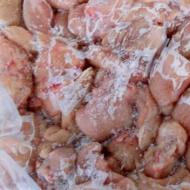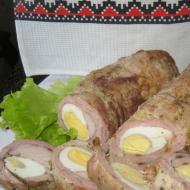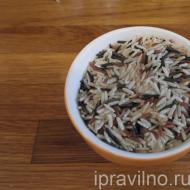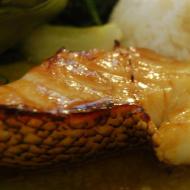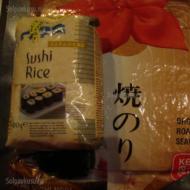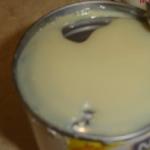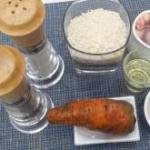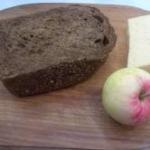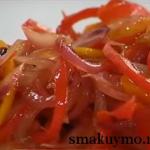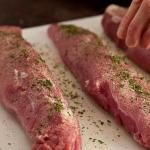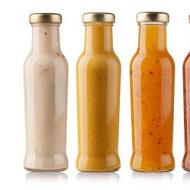
How and how long to store sauces. Requirements for the quality of sauces. shelf life Long-term storage of sauces
A little about the shelf life in public catering. The State Sanitary and Epidemiological Program, which must be carried out at each enterprise in accordance with the norms and rules of SanPiN 2.3.2.1324-03 "Hygienic requirements for shelf life and storage conditions of food products.", Approved by the Chief State Sanitary Doctor of the Russian Federation on May 21, 2003, from 25 June 2003.
The highest air temperature in the refrigerator for storing frozen meat should be -18 °C. Relative humidity in storage rooms varies from 95% to 98%. It is possible to store frozen meat at -12 °C, if the refrigerator is not equipped with technical means to create the required temperature. Shelf life limits for frozen bulk meat products of various types are listed in Table 1.
Table 1.
| Type of meat | t of air in the refrigerated storage chamber, °C | Max number of months |
| Beef (quarters and half carcasses) | -12 | 8 |
| -18 | 12 | |
| -20 | 14 | |
| -25 | 18 | |
| Lamb (carcasses) | -12 | 6 |
| -18 | 10 | |
| -20 | 11 | |
| -25 | 12 | |
| Pork (half carcasses) | -12 | 3 |
| -18 | 6 | |
| -20 | 7 | |
| -25 | 12 |
Frozen meat down to -8 °C in the thickness of the thigh must be stored in refrigerators, stacked in tight stacks. Beef (quarters) and pork (half carcasses) are stored folded in the same way in containers. Containers are installed in two or three tiers along the height of the chamber. Different types of meat should not be placed in the same container.
Storage of frozen blocks with meat and offal
The term is not more than six months. The temperature in the offal storage room should not exceed -12 °C. In some cases, it is possible to store offal in the same refrigerator compartment with frozen meat. The maximum periods for meat and offal blocks are listed in Table 2.
Table 2.
| Type of meat | t air in cold store storage | Maximum shelf life | |
| meat | offal | ||
| Beef | -12 | 8 | 4 |
| -18 | 12 | 6 | |
| -20 | 14 | 7 | |
| -25 | 18 | 10 | |
| Mutton | -12 | 6 | 4 |
| -18 | 10 | 6 | |
| -20 | 11 | 7 | |
| -25 | 12 | 8 | |
| Pork | -12 | 3 | 4 |
| -18 | 6 | 5 | |
| -20 | 8 | 5 | |
| -25 | 12 | 6 | |
Frozen poultry meat complies with the specifications of GOST 21784-76. Poultry meat is stored in refrigerators, where relative humidity ranges from 85% to 95%. The shelf life of poultry meat from the date of production is listed in Table 3.
Table 3
| bird species | Maximum shelf life, in months, at t | |||||||
| -12°C | -15°C | -18°C | -25 °C and below | |||||
| carcasses | carcasses | carcasses | carcasses | |||||
| unpackaged | Packed in film | unpackaged | Packed in film | unpackaged | Packed in film | unpackaged | Packed in film | |
| chickens | 5 | 8 | 7 | 10 | 10 | 12 | 12 | 14 |
| chickens Broiler chickens Turkey poults Cesaryata |
4 | 8 | 6 | 10 | 8 | 12 | 11 | 14 |
| geese | 4 | 6 | 5 | 8 | 7 | 10 | 11 | 12 |
| Goslings | 3 | 6 | 4 | 8 | 6 | 10 | 10 | 12 |

Storage of frozen meat from the date of production
Chilled and supercooled meat is stored in a suspended position. Carcasses and half carcasses are fixed in storage chambers on overhead rails. The gaps between the carcasses are 20 - 30 mm. The maximum shelf life of frozen meat from the date of manufacture is listed in Table 4.
Table 4
SanPiN food products
The shelf life and storage conditions of food products are established by SanPiN 42-123-4117-86. Sanitary rules are intended for all enterprises that are somehow connected with perishable products.
The maximum shelf life for rapidly perishable products that cannot be stored without cold, at t not higher than +6 ° C, is no more than 3 days. Such products include: dairy, meat, fish, vegetable, confectionery products, etc.

The maximum shelf life of perishable products, as well as the shelf life of the final product with a temperature regime of 4 ± 2 ° C, are listed in Table 5.
Table 5
| Name of product | Best before date | Days/hours |
| Meat and meat products. Poultry, eggs and their products | ||
| Semi-finished products from meat without bones 1. Semi-finished products (big pieces):
|
||
2. Semi-finished products (small pieces):
|
||
3. Semi-finished minced meat:
|
1 | Day. |
4. Minced meat:
|
1 | Day. |
| 5. Meat and bone semi-finished products; | 36 | Hour. |
| 6. Offal of slaughter animals; | 2 | Day. |
| Semi-finished products made from poultry meat | ||
7. Natural meat and bone and boneless semi-finished products from poultry meat:
|
||
| 8. Chopped semi-finished products from poultry meat in breading and without it; | 18 | Hour. |
| 9. Chicken mince; | 12 | Hour. |
| 10. Semi-finished products from poultry offal and by-products; | 1 | Day. |
| 11. Soup and other sets; | 12 | Hour. |
| Ready-made culinary dishes from meat and meat products | ||
| 12. Boiled meat; | 1 | Day. |
| 13. Fried meat; | 36 | Hour. |
| 14. Fried meat products; | 1 | Day. |
| Meat dishes: | ||
| 15. Dumplings, belyashi, pancakes, pies; | 1 | Day. |
| 16. Cheeseburgers, hamburgers, ready-made pizza; | 1 | Day. |
| 17. Meat products in the form of jelly; | 12 | Hour. |
| 18. Boiled and fried organ meats; | 1 | Day. |
| 19. Pates; | 1 | Day. |
| Culinary dishes made from poultry meat | ||
| 20. Carcasses of a bird and its parts of all types of smoking; | 72 | Hour. |
| 21. Cooked poultry dishes; | 2 | Day. |
| 22. Minced poultry dishes, with sauces and side dishes; | 12 | Hour. |
| 23. Pies and dumplings made from poultry; | 1 | Day. |
| 24. End products made from poultry in a jelly-like form; | 12 | Hour. |
| 25. Offal and pates made from poultry; | 1 | Day. |
| 26. Boiled eggs; | 36 | Hour. |
| Sausages from different types of meat and poultry | ||
27. Boiled sausages produced in accordance with GOST:
|
||
28. Boiled sausages in accordance with GOST in sealed casings:
|
||
| 29. Boiled sausages and sausages produced in accordance with GOST; | 3 | Day. |
| 30. Boiled sausages and sausages in hermetic casings; | 7 | Day. |
| 31. Boiled sliced sausages, sausages, sausages, packed under vacuum, under modified atmosphere conditions; | 5 | Day. |
| 32. Boiled meat products; | 3 | Day. |
| 33. Sliced cooked meat products packed under vacuum, under modified atmosphere conditions; | ||
| 34. Liver and blood sausages; | 2 | Day. |
| 35. Sausages with offal; | 2 | Day. |
36. Sausage boiled poultry products:
|
||
| 37. Cooked sausages packed under vacuum, under modified atmosphere conditions; | 5 | Day. |
| , non-fish products and products thereof | ||
| Semi-finished products from fish | ||
| 38. Fish of various kinds; | 2 | Day. |
| 39. Fish fillet; | 1 | Day. |
| 40. Special cut fish; | 1 | Day. |
| 41. Minced fish and final products from it, with a flour component; | 1 | Day. from -2 to +2°C |
| 42. Chilled bivalves and crustaceans; | 12 | Hour. |
| Culinary fish products without heat treatment | ||
| 45. Products from salted fish, chopped; | 1 | Day. |
| 46. Salads from seafood and fish, without dressing; | 12 | Hour. |
| 47. Caviar oil, herring, etc.; | 1 | Day. |
| 48. Boiled shrimps and crayfish; | 12 | Hour. |
| 49. Structured products; | 2 | Day. |
| Fish culinary products with heat treatment | ||
| 50. Fish prepared in many ways; | 36 | Hour. |
| 51. Minced fish products, baked dishes and pies; | 1 | Day. |
| 52. Fish of different types and hot smoked rolls; | 2 | Day. |
| 53. Mixed dishes from different types of fish; | 1 | Day. |
| 54. Jelly-like products from fish; | 1 | Day. |
| Caviar culinary products | ||
| 55. thermally processed products; | 2 | Day. |
| 56. Mixed fish products without heat treatment; | 12 | Hour. |
| 57. Pastes from fish of a polymeric container; | 2 | Day. |
| Milk and dairy products, cheeses. | ||
58. Pasteurized cream and milk, buttermilk and whey:
|
36 | Hour. |
| 59. Baked milk; | 5 | Day. |
| 60. Dairy products (liquid); | 3 | Day. |
| 61. Fermented milk products containing bifidobacteria (liquid); | 3 | Day. |
| 62. Koumiss from mare's and cow's milk; | 2 | Day. |
| 63. Ryazhenka; | 2 | Day. |
| 64. Sour cream and products containing sour cream; | 3 | Day. |
| 65. Cottage cheese and products from it, not thermally processed; | 3 | Day. |
| 66. Curd and products from it, thermally processed; | 5 | Day. |
| 67. Pasty milk protein products; | 3 | Day. |
| 68. Culinary curd dishes; | 1 | Day. |
| 69. Cottage cheese casseroles and puddings; | 2 | Day. |
| 70. Homemade cheeses; | 3 | Day. |
| 71. Cream cheese; | 5 | Day. |
| 72. Cheeses without maturation (brine and soft); | 5 | Day. |
| 73. Cheese butter; | 2 | Day. |
| Dairy products for children | ||
74. Dairy products:
Other fermented milk products; |
36 | Hour. |
| 75. Curd for children; | 36 | Hour. |
| 76. Products from cottage cheese; | 1 | Day. |
77. Sterilized products:
|
||
| 78. Food products for preventive or therapeutic nutrition, which have a fermented soy or non-dairy base; | 36 | Hour. |
| vegetable products | ||
| Semi-finished products from greens and vegetables: | ||
| 79. Raw peeled sulphated potatoes; | 2 | Day. |
| 80. Fresh cabbage; | 12 | Hour. |
| 81. Raw peeled vegetables: beets, carrots,; | 1 | Day. |
| 82. Sliced and processed radish and radish; | 12 | Hour. |
| 83. Parsley and celery processed; | 1 | Day. |
| 84. Processed green onions; | 18 | Hour. |
| 85. Dill processed; | 18 | Hour. |
| culinary specialties | ||
86. Salads from raw fruits and vegetables:
|
||
87. Salads from raw and canned vegetables, eggs, etc.
|
||
| 88. Salads with salted, pickled and pickled vegetables; | 36 | Hour. |
89. Salads from boiled vegetables:
|
||
| 90. Dishes from vegetables cooked in different ways; | 1 | Day. |
91. Salads from meat, poultry, fish or smoked meats:
|
||
92. Side dishes:
|
||
| 93. Dressings and sauces for second courses; | 2 | Day. |
| Bakery and confectionery | ||
| Semi-finished dough products; | ||
| 94. Yeast dough; | 9 | Hour. |
| 95. Unleavened puff pastry; | 1 | Day. |
| 96. Sand dough; | 36 | Hour. |
| Culinary products | ||
97. Baked Yeast Dough Bakery Products:
|
||
| 98. Fried bakery products (chebureks, belyashi, etc.); | 1 | Day. |
| 99. Wheat or semolina meatballs; | 18 | Hour. |
| Flour confectionery, drinks and sweet dishes | ||
100. Cakes and cakes:
|
||
101. Rolls on a biscuit basis:
|
||
| 102. Mousses and jellies; | 1 | Day. |
| 103. Creams for confectionery; | 1 | Day. |
| 104. Whipped cream; | 6 | Hour. |
105. Industrial kvass:
|
||
| 106. Freshly squeezed juices (fruit and vegetable). | 2 | Day. |
If the catering establishment does not comply with the established terms and conditions for storing food and end products, pathogenic microorganisms can multiply that can cause acute intestinal and bacterial poisoning.
The quality of the sauce is determined by consistency, color, taste, aroma. When assessing the quality of sauces with fillers (onion, onion with gherkins, etc.), the shape of the cut and the amount of filler are taken into account.
Hot sauces with flour should have the consistency of liquid sour cream (liquid sauces), be elastic, homogeneous, without lumps of boiled flour and particles of unmashed vegetables. Medium-thick sauces used for baking have the consistency of thick sour cream. Thick milk sauce for stuffing should be similar to viscous semolina.
Vegetables that are part of the sauce in the form of a filler should be finely and neatly chopped, evenly distributed in the sauce, soft. There should be no film on the surface of the sauce.
The hollandaise sauce should have a smooth consistency, with no grains or flakes of curdled protein. There should be no grease on the surface of the sauce.
In polish and cracker sauces, the oil should be clear. The eggs for the Polish sauce are coarsely chopped.
Oil should not appear on the surface of mayonnaise; uniform consistency.
Vegetables in marinades should be neatly chopped, soft; horseradish for sauce - finely grated.
Sauce color should be characteristic for each group of sauces: red - from brown to brownish red; white - from white to slightly grayish; tomato - red. Milk and sour cream sauces - from white to light cream, sour cream with tomato - pink, mushroom - brown, marinade with tomato - orange-red, mayonnaise - white with a yellow tint. The color depends on the products used and the adherence to the technological process.
The taste and smell of the sauce- the main indicators of its quality. For sauces on broths, a pronounced taste of meat, fish, mushrooms with the smell of browned vegetables and seasonings is characteristic.
The main red sauce and its derivatives should have a meaty taste with a sweet and sour taste and smell of onions, carrots, parsley, peppers, bay leaves.
White sauces on meat broth should have the taste of broths with a slight smell of white roots and onions, with a slightly sour aftertaste. The taste of tomato sauce is pronounced sweet and sour.
Fish sauces should have a sharp specific smell of fish, white roots and spices.
Mushroom sauces - pronounced aroma of mushrooms.
Dairy and sour cream sauces should taste like milk and sour cream. You can not use burnt milk or very sour sour cream for their preparation.
Unacceptable defects in sauces with flour are: the smell of raw flour and stickiness, the taste and smell of burnt flour, the presence of a large amount of salt, the taste and smell of raw tomato puree.
Egg-butter sauces and cracker sauce have a slightly sour taste and aroma of butter.
Marinades should have a sour-spicy taste, aroma of vinegar, vegetables and spices. The taste of raw tomato puree and too sour taste are unacceptable.
Mayonnaise sauce and its derivatives should not be bitter or too spicy, and horseradish sauce with vinegar should not be bitter or not spicy enough.
Store basic hot sauces in a water bath at temperatures up to 80°C for 3 to 4 hours. Basic sauces can be stored for up to 3 days. To do this, they are cooled to room temperature and placed in a refrigerator at a temperature of 0-5°C. Sour cream sauces are stored at a temperature of 75°C for no more than 2 hours from the moment of preparation. Milky liquid sauce - hot at a temperature of 65-70 ° C for no more than 1-1.5 hours, since during long-term storage it darkens due to caramelization of milk sugar. Thick milk sauce should be stored refrigerated at a temperature of 5 ° C for no more than a day. Milk sauces of medium density are not subject to storage; they are prepared immediately before use. Polish and cracker sauces can be stored for up to 2 hours. Butter mixtures are stored in the refrigerator for several days. To increase the shelf life, they are wrapped in parchment, cellophane or plastic wrap. Mayonnaise of industrial production is stored at a temperature of 5°C for 3 months. Mayonnaise of own production and salad dressings are stored in the refrigerator for 1-2 days, marinades and horseradish sauce - chilled for 2-3 days.
The quality of the sauce is determined by consistency, color, taste and aroma. When assessing the quality of sauces with fillers (sauce with gherkins, white sauce with vegetables, etc.), the shape of the cut and the amount of filler are taken into account.
The vegetables included in the sauce as a filler should be finely and neatly chopped, evenly distributed with the sauce, soft. There should be no film on the surface of the sauce. For these purposes, sauces are seasoned (butter is added to the sauce and thoroughly mixed) and pinched (a thin layer of butter is distributed on the surface to prevent the formation of a surface film).
Sauces should have a consistency, color, taste and aroma characteristic of each group.
Ready-made red sauces are characterized by a homogeneous consistency of liquid sour cream, without lumps of boiled flour and particles of unmashed vegetables. They should have a rich meat taste with a sweet and sour taste, the smell of onions, carrots, parsley, pepper and bay leaves, the color is from brown to brown-red.
White sauces should have a homogeneous consistency of thick cream, without lumps of boiled flour, a pleasant taste with a slight sourness, a smell of white roots and onions, and a color from white to slightly grayish.
Other hot sauces with flour should have the consistency of liquid sour cream, be homogeneous, without lumps of boiled flour and particles of unmashed vegetables. Medium-density sauces used for baking have the consistency of thick sour cream.
Thick milk sauce for stuffing should be similar to viscous semolina.
The hollandaise sauce should have a smooth consistency, with no grains or flakes of curdled protein. There should be no grease on the surface.
In polish and cracker sauces, the oil should be clear. Eggs for Polish sauce should be coarsely chopped.
On the surface of mayonnaises, oil should not protrude, their consistency is uniform.
Vegetables in marinades should be neatly chopped, soft; horseradish for sauce finely grated.
The color of tomato sauces is red, milk and sour cream sauces are from white to light cream, sour cream with tomato is pink, marinade with tomato is orange-red, mayonnaise is white with a yellow tint, mushroom is brown. The color depends on the products used and the adherence to the technological process.
Fish sauces should have a sharp specific smell of fish, white roots and spices.
Mushroom sauces should have a pronounced aroma of mushrooms.
Dairy and sour cream sauces should taste like milk or sour cream. You can not use burnt milk or very sour sour cream for their preparation.
Inadmissible defects in sauces with flour are: the smell of raw flour and stickiness, the taste and smell of burnt flour, the salty taste and the taste and smell of raw tomato puree.
Egg-butter sauces and cracker sauce have a slightly sour taste and aroma of butter.
Marinades should have a sour-spicy taste, aroma of vinegar, vegetables and spices. The taste of raw tomato puree and too sour taste are unacceptable.
Mayonnaise sauce and its derivatives should not have a bitter taste and be too spicy, and horseradish sauce with vinegar should not be bitter or not spicy enough.
The main hot sauces are stored in a water bath at a temperature not exceeding 80 0 C for 3 to 4 hours. The surface of the sauce is protected with butter, and in order to prevent the formation of a surface film, the dishes with the sauce are covered with a lid. Basic sauces can be stored for up to 3 days, for this they are cooled to room temperature and placed in a refrigerator at a temperature
0 - 5 0 C. When storing sauces in cold form, their taste and smell are preserved much better than when stored hot.
Sour cream sauces are stored at a temperature of 75 0 C for no more than 2 hours from the moment of preparation.
Milky liquid sauce is stored hot at a temperature of 65-70 0 C for no more than 1-1.5 hours, since with longer storage it darkens due to caramelization of lactose milk sugar, and the taste of the sauce also deteriorates. Thick milk sauce is stored refrigerated for no more than a day at a temperature of 5 0 C.
Milk sauces of medium thickness are not subject to storage and are prepared immediately before use.
Polish and cracker sauces can be stored for up to 2 hours.
Oil mixtures are stored in the refrigerator for several days. To increase the shelf life, the molded oil mixtures are wrapped in parchment, cellophane or plastic wrap.
Industrial table mayonnaise is stored at a temperature of 18 0 C for up to 45 days, and at a temperature of 5 0 C for 3 months. Mayonnaise sauce prepared at a catering establishment, its derivative sauces, as well as salad dressings are stored for 1-2 days at a temperature of 10-15 0 C in non-oxidizing dishes (enamelled or ceramic), dressings in bottles.
Marinades and horseradish sauce with vinegar are stored chilled for 2-3 days in the same container with a closed lid.
The quality of the sauce is determined by consistency, color, taste and aroma. When assessing the quality of sauces with fillers (sauce with gherkins, white sauce with vegetables, etc.), the shape of the cut and the amount of filler are taken into account.
Vegetables that are part of the sauce in the form of a filler should be finely and neatly chopped, evenly distributed with the sauce, soft. There should be no film on the surface of the sauce. For these purposes, sauces are seasoned (butter is added to the sauce and thoroughly mixed) and pinched (a thin layer of butter is distributed on the surface to prevent the formation of a surface film).
Sauces should have a consistency, color, taste and aroma characteristic of each group.
Ready-made red sauces are characterized by a homogeneous consistency of liquid sour cream, without lumps of boiled flour and particles of unmashed vegetables. They should have a rich meat taste with a sweet and sour taste, smell of onions, carrots, parsley, pepper and bay leaves, color from brown to brown-red.
White sauces should have a homogeneous consistency of thick cream, no lumps of boiled flour, a pleasant taste with a slight sourness, a smell of white roots and onions, and a color from white to slightly grayish.
Other hot sauces with flour should have the consistency of liquid sour cream, be homogeneous, without lumps of boiled flour and particles of unmashed vegetables. Sauces of medium density, used for baking, have the consistency of thick sour cream. Thick milk sauce for stuffing should be similar to viscous semolina.
The hollandaise sauce should have a smooth consistency, with no grains or flakes of curdled protein. There should be no grease on the surface. In polish and cracker sauces, the oil should be clear. Eggs for polish sauce should be coarsely chopped. Oil should not protrude on the surface of mayonnaise, their consistency is homogeneous.
Vegetables in marinades should be neatly chopped, soft; horseradish for sauce - finely grated. The color of tomato sauces is red, milk and sour cream sauces are from white to light cream, sour cream with tomato is pink, marinade with tomato is orange-red, mayonnaise is white with a yellow tint, mushroom is brown. The color depends on the products used and the adherence to the technological process.
Fish sauces should have a sharp specific smell of fish, white roots and spices. Mushroom sauces should have a pronounced mushroom flavor. Dairy and sour cream sauces should taste like milk or sour cream. Do not use burnt milk or very sour sour cream for their preparation.
Inadmissible defects in sauces with flour are: the smell of raw flour and stickiness, the taste and smell of burnt flour, the salty taste and the taste and smell of raw tomato puree. Egg-butter sauces and cracker sauce have a slightly sour taste and aroma of butter.
Marinades should have a sour-spicy taste, aroma of vinegar, vegetables and spices. Unacceptable smack of raw tomato puree and too sour taste. Mayonnaise sauce and its derivatives should not have a bitter taste and be too spicy, and horseradish sauce with vinegar should not be bitter or not spicy enough.
store basic hot sauces in a water bath at a temperature not exceeding 80 ° C for 3 to 4 hours. The surface of the sauce is protected with butter, and so that a surface film does not form, the saucepan with the sauce is covered with a lid. Basic sauces can be stored for up to 3 days, for this they are cooled to room temperature and placed in a refrigerator at a temperature of 0 ... 5 ° C. When storing sauces cold, their taste and smell are preserved much better than when stored hot.
Sour cream sauces store at a temperature of 75 "C for no more than 2 hours from the moment of preparation.
Milk liquid sauce stored hot at a temperature of 65 ... 70 ° C for no more than 1 ... 1.5 hours, since with longer storage it darkens due to caramelization of milk sugar - lactose, and the taste of the sauce also deteriorates. Thick milk sauce Store refrigerated for no more than a day at a temperature of 5 "C. Medium thick milk sauces are not subject to storage and are prepared immediately before use.
Polish and cracker sauces can be stored up to 2 hours.
Oil blends keep in the refrigerator for several days. To increase the shelf life, the molded oil mixtures are wrapped in parchment, cellophane or plastic wrap. It is impossible to store oil mixtures for a long time, since the surface of the mael is oxidized by atmospheric oxygen and turns yellow under the influence of light, which also leads to a deterioration in taste.
Industrial table mayonnaise store at a temperature of 18 ° C for up to 45 days, and at a temperature of 5 ° C - 3 months. Sauce mayonnaise, prepared at a public catering enterprise, its derivative sauces, as well as salad dressings, are stored for 1 ... 2 days at a temperature of 10 ... 15 ° C in non-oxidizing dishes (enamelled or ceramic), dressings - in bottles.
Marinades and horseradish sauce with vinegar stored refrigerated for 2 ... 3 days in the same container with a closed lid.
Steam sauce. The main white sauce is seasoned with citric acid, boiled and boiled white wine is added. Served with stewed meat dishes, chickens, chickens, veal, etc. You can add a decoction of champignons to it.
White sauce with egg. Egg yolks are rubbed with margarine or butter, cream or broth is added and heated in a water bath (75-80 ° C), stirring continuously. This mixture, with stirring, is added to a hot white sauce (75-80 ° C), seasoned with grated nutmeg, citric acid, and salt. Served with dishes of stewed and boiled veal, chickens, chickens, lamb.
White sauce with vegetables. Carrots, parsley or celery and onions are cut into small cubes and sautéed for 3-5 minutes, a little broth is added and, having covered the dishes with a lid, simmer until tender. Finely chopped turnips and bean pods are boiled separately. Ready vegetables are added to the white sauce, boiled, seasoned with salt, citric acid and oil. Served with dishes of boiled lamb, rabbit, poultry, steam meat cutlets.
7. Requirements for the quality and storage of sauces
The liquid part of sauces with flour should be homogeneous, without lumps; the oil does not flake off. Side dishes introduced into the sauce should be soft, brought to readiness. The taste and aroma of sauces are well expressed.
Hot sauces with flour are stored on a food warmer in a sealed container for no more than 3 hours. Sauces are served for distribution in small batches for sale within 1-1.5 hours. Ready-made cold sauces are served for distribution in quantities that can be sold in 1-2 hours Keep in mind that hollandaise sauces are very unstable, so they should be stored in a water bath at a temperature not exceeding 80 "C.
In restaurants, ceramic and metal gravy boats of various capacities are used to serve sauces.
When culling, first determine the consistency of the sauce, pouring it in a thin stream and tasting it. Most sauces should have the consistency of liquid sour cream when hot.
Then they determine the color, taste and aroma, the consistency of the fillers, the shape of the side dishes and the composition (onions, cucumbers, root crops, etc.). Decisive in the assessment of sauces are taste and aroma. .
Inadmissible defects in sauces: extraneous unpleasant odors and tastes; the smell of raw flour and stickiness (the flour was not passivated); the smell and taste of burnt flour; watery taste and faint smell of meat, fish and poultry (weak broth); salting; smell and taste of raw tomato (badly sautéed tomato); the presence of lumps of brewed flour (flour passivation was brewed with very hot water and not filtered); separation of oil in sauces with egg-butter lezon; the presence of dark grains and a bitter aftertaste (burnt vegetables); poorly peeled vegetables.
Red meat sauces should have a rich meat taste, close to the taste of juice from roasting meat, with a sweet and sour taste, color from brown to brown-red, aroma of sautéed vegetables and spices. The smell of bay leaf should not prevail in the "bouquet".
In sauces with wine, the aroma of wine should be well expressed. Vinegar in sauces should not be felt. In onion sauces, the onion should be finely chopped. These sauces have a strong aroma of sautéed onions and spices. The roots in sauces with fillers should be soft. Overcooked or very dense vegetables are unacceptable.
A defect in mustard sauce is curdled grains of mustard. Fillers (vegetables, onions, capers, gherkins, etc.) should be evenly distributed throughout the mass. Meat white, tomato and sour cream sauces should have the taste of meat white sauces (in meat or chicken broth), with the aroma of sautéed white roots and onions. Steam sauce should have a pleasant sour taste. The consistency is elastic, like cream, without lumps and grains. The color is white or cream. The aroma is delicate, without the smell of bay leaf. The absence of citric acid in the steam sauce, white with egg is considered a defect.
The main defects of sour cream sauces are the use of low-quality sour cream - with high acidity, extraneous flavors or lack of sour cream. In addition, there may be defects depending on the flour passivation - a burnt taste, lumpiness. If the sauce is not boiled well, then the smell of raw sour cream is felt.
Fish sauces should have a characteristic, strongly pronounced taste and aroma of white roots, fish, spices. The main defect is the insufficient concentration of the broth. Fish sauces are bitter if the gills were not removed from the heads of the fish when the broth was boiled, or if the food waste was not washed well. Filler defects are: the presence of pitted olives, poor peeling of root crops, violation of the cut shape, the presence of unpeeled or overripe cucumbers. An incomplete set of fillers is evaluated as a marriage. A particularly frequent violation is the absence of white roots.
7.1 Processes involved in the preparation of the sauce
When preparing a white base sauce, the flour is sautéed with fat. Flour is added to sauces to give a certain consistency. Raw flour gives sauces an unpleasant stickiness and taste. Therefore, the flour is passivated, i.e. dried without color change at 120C or with color change to light brown at 150C. A higher temperature is not used, as the flour acquires an unpleasant aftertaste of "burnt".
When flour is passed through, partial (at 120C) or almost complete (at 150C) denaturation of proteins occurs. They lose their ability to swell and, when combined with broth (water), do not form gluten.
The appearance of colored products and a specific smell is explained by the reaction of melanoidin formation.
Starch has a significant effect on the consistency of the sauce. During passaging, its dextrinization occurs, while starch grains are partially destroyed and lose their ability to gelatinize. Therefore, the sauces are elastic, non-sticky, with a pleasant aroma.
All processes associated with swelling and gelatinization of starch during further boiling of flour with liquid end after about 20 minutes, so sauces should not be boiled for a long time.
Passage flour can be with or without fat. To obtain fat passivation, the sifted flour is poured into melted fat and heated, stirring continuously. Fat ensures uniform heating of the flour and, upon subsequent dilution with broth, prevents the formation of lumps. Fat passivation is usually diluted with hot broth.
Dry, or fat-free, passivation is prepared by heating the sifted flour with a layer of more than 5 cm. To prepare a large amount of dry passivation, the flour is mixed with salt (up to 20% of the flour mass) and heated while stirring. Salt prevents the formation of lumps when breeding passivation with broth. Dry passivation is diluted with a small amount of broth cooled to 50 ° C in order to avoid premature gelatinization of starch and the formation of lumps.
Depending on the color, red and white passivation is distinguished.
7.1.1 Swelling and gelatinization of starch
Swelling is one of the most important properties of starch, which affects the consistency and shape, volume and yield of finished products.

